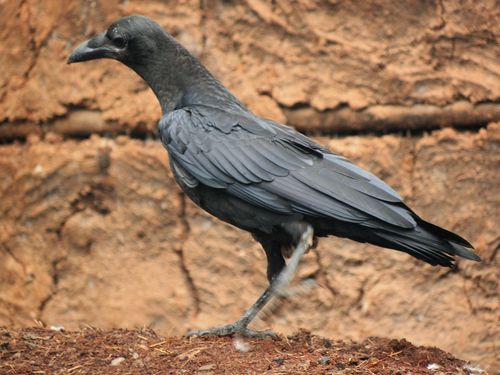
Fan-tailed Raven
The Fan-tailed Raven (*Corvus rhipidurus*) is a distinctive corvid species found in the Middle East and parts of Africa. It is well-adapted to arid and semi-arid environments, often found near cliffs and rocky outcrops. Unlike many other raven species, the Fan-tailed Raven is characterized by its relatively short, broad tail which gives it a unique silhouette in flight. Ecologically, it plays a role as both a scavenger and a predator, contributing to nutrient cycling and controlling populations of small animals. It holds no major known cultural significance, though it is sometimes viewed with superstition in some regions.
47-58 cm
Length
100-120 cm
Wingspan
Least Concern
Conservation Status
Distribution
The Fan-tailed Raven's range spans across the Middle East, including the Arabian Peninsula, and extends into parts of East Africa, including Somalia, Eritrea, Djibouti, and Sudan. They are also found in parts of North Africa. They do not typically undertake long-distance migrations, but may move locally in response to food availability.
Lifespan
Information on lifespan in the wild is limited, but other *Corvus* species can live for 10-15 years or more.
Fan-tailed Raven's Habitat
Habitat Types
Deserts, Semi-deserts, Rocky cliffs, Mountain slopes, Wadis
Climate Zones
Arid, Semi-arid, Tropical
Adaptations
They are well-suited to arid environments, capable of surviving in areas with limited water sources. Their dark plumage may offer some protection from intense solar radiation, and their strong legs and feet allow them to navigate rocky terrain.
Variations
No recognized subspecies exist; however, some minor variations in size and plumage darkness may occur across their range, though these are not formally classified.
Appearance
Breeding Plumage
Plumage is generally consistent year-round.
Seasonal Feather Changes
No significant seasonal variations.
Sex Based Plumage Differences
Minimal to none; males and females have similar plumage.
Notable Features
Short, fan-shaped tail, Glossy black plumage, Heavy, slightly arched bill, Strong legs and feet
Diet and Feeding
Primary Foods
Carrion, Insects, Small vertebrates (lizards, rodents), Fruits, Seeds, Human refuse
Foraging Behavior
Fan-tailed Ravens are opportunistic omnivores, foraging on the ground, in trees, and around human settlements. They often soar and scan for food, and may also follow other animals to locate carcasses.
Specializations
Their strong bill is well-suited for tearing flesh and cracking seeds.
Seasonal Diet Variations
Diet may vary depending on local food availability. For example, they might consume more fruits during fruiting seasons or rely more on carrion during periods of drought.
Behavior
Social Structure
Fan-tailed Ravens are often seen in pairs or small family groups. They may also form larger flocks, particularly at abundant food sources or roosting sites.
Communication
Deep croaking calls, Rattling calls, Other vocalizations, Visual displays (e.g., bill pointing, fluffing feathers)
Migration
Generally non-migratory, but may undertake local movements in response to food availability.
Territorial or Group Behaviors
Pairs defend nesting territories during the breeding season. Outside of breeding, they may be more tolerant of other individuals, especially at feeding sites.
Conservation
Threats
Habitat loss (due to agriculture and urbanization), Persecution (due to perceived threats to livestock), Poisoning (from consuming poisoned carcasses intended for other predators)
Protection Programs
No specific large-scale conservation programs are currently focused on the Fan-tailed Raven, but general bird conservation efforts in their range may benefit them.
Local National Laws
Protected under general wildlife laws in many countries within their range.
Population Trend
Stable
Population Estimates
The global population is estimated to be between 100,000 and 500,000 individuals.
Interesting Facts
They are known for their acrobatic flight displays.
These displays are often performed during courtship or territorial defense.
They are highly intelligent birds.
Like other corvids, they are capable of problem-solving and using tools.
They can mimic sounds.
Although not as renowned for mimicry as some other corvids, they can imitate other bird calls and even human speech in some cases.
Faqs about Fan-tailed Raven
What is the difference between a Fan-tailed Raven and a Common Raven?
The Fan-tailed Raven has a shorter, wedge-shaped tail, a smaller bill, and is generally found in more arid habitats compared to the Common Raven, which has a longer, diamond-shaped tail.
Are Fan-tailed Ravens dangerous to humans?
No, they are not typically aggressive towards humans unless their nest is threatened.
Do Fan-tailed Ravens mate for life?
Like many other corvids, Fan-tailed Ravens are believed to form long-term pair bonds, often described as mating for life.
Copyright @ Nature Style Limited. All Rights Reserved.
 English
English